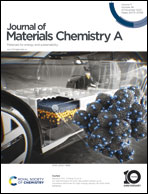Boride-induced phase tuning of defect-introduced MoS2 nanosheets to boost the electrocatalytic hydrogen evolution reaction†
Abstract
Transition metal dichalcogenides have garnered intense research interest owing to their promising functionalities as non-noble-metal catalysts. However, their catalytic activity and structural instability must be further improved. In this study, to improve the electrocatalytic performance of transition metal dichalcogenides, an effective soft-chemical phase tuning approach to improve electrocatalytic performance was developed by defect-assisted boride substitution of interlayer-expanded MoS2 nanosheets. The NaBH4 treatment for tetrapropylammonium-assembled MoS2 nanosheets containing a considerable number of anion vacancies was found to be effective not only in forming the coordination bonding of boride ions to defective Mo sites but also in tuning the ratio of 1T′/2H phases. The boride-substituted MoS2 nanosheets exhibited significantly improved electrocatalytic activity and durability for the hydrogen evolution reaction (HER) over those of boride-free MoS2 nanosheets. The improvements in electrocatalytic functionality following NaBH4 treatment are attributable to the co-stabilization of 1T′ and 2H phases, enhancement of hydrogen adsorption, and the improvement of charge transfer and HER kinetics. This defect-assisted boride substitution approach provides a powerful method to develop high-performance transition metal dichalcogenide-based catalysts.

- This article is part of the themed collection: Celebrating the scientific accomplishments of RSC Fellows


 Please wait while we load your content...
Please wait while we load your content...